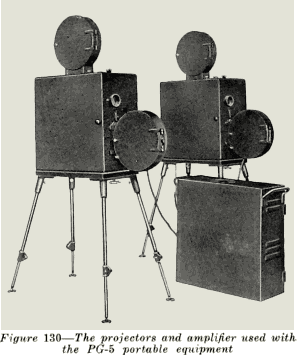As will be seen in Figure 131, the projector mechanism combines both a picture projecting mechanism,
similar in principle and construction to a standard projector, and a sound reproducing mechanism
similar to the larger Photophone sound heads.
The projection lamp is a 1000 watt incandescent lamp operated at 110 volts, and is contained in a fireproof lamp housing, in a pre-focused socket which insures its proper position in relation to the reflector
and condenser lens. The standard "quarter size" projection lens projects a picture covering the screen,
about nine feet wide, at forty feet. Longer focus lenses are available for longer throws.
The intermittent movement is similar in action to those on standard projectors, but of slightly different
construction. Figure 131 shows film threaded in the projector, illustrating the similarity to larger
projectors. The framing and focusing knobs are located on the top of the projector, thus making it
unnecessary to open the projector doors when running.

The projector is driven by means of a one-eighth horse power, single-phase, 110 volt AC motor,
operating at 50 or 60 cycles. An adjustable belt drive transmits the power to the projector mechanism,
the adjustment being effected by moving the motor until the proper tension is secured. The adjustment
bolts illustrated are used for this purpose.
Projectors intended for use on 50 cycle power supply systems are supplied with two motor pulleys. The
larger of the two pulleys is for use when the power supply available is 110 volt, 50 cycle. This pulley is
mounted on the motor shaft when the
projector is shipped from the factory. The smaller of the two pulleys is for use in case the projector is
used on a 60 cycle supply. It is important that the right pulley be used, otherwise the film speed will be
incorrect.
2
